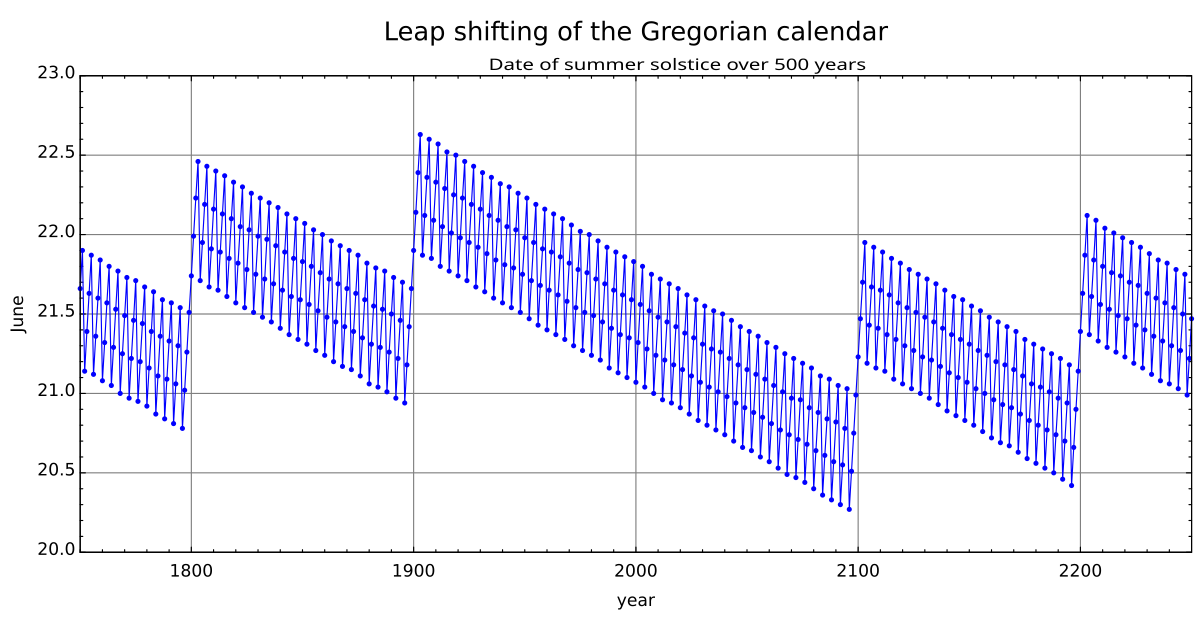cross-posted from: https://lemmy.world/post/19541930
Preferably a Holocene colander?
A consensus view was formally adopted by the IUGS in 2013, placing its start at 11,700 years before 2000 (9701 BC), about 300 years more recent than the epoch of the Holocene calendar.[6]
Some problems with Gregorian calendar
The Gregorian calendar improves the approximation made by the Julian calendar by skipping three Julian leap days in every 400 years, giving an average year of 365.2425 mean solar days long.[82] This approximation has an error of about one day per 3,030 years[s] with respect to the current value of the mean tropical year. However, because of the precession of the equinoxes, which is not constant, and the movement of the perihelion (which affects the Earth’s orbital speed) the error with respect to the astronomical vernal equinox is variable; using the average interval between vernal equinoxes near 2000 of 365.24237 days[83] implies an error closer to 1 day every 7,700 years. By any criterion, the Gregorian calendar is substantially more accurate than the 1 day in 128 years error of the Julian calendar (average year 365.25 days).
In the 19th century, Sir John Herschel proposed a modification to the Gregorian calendar with 969 leap days every 4,000 years, instead of 970 leap days that the Gregorian calendar would insert over the same period.[84] This would reduce the average year to 365.24225 days. Herschel’s proposal would make the year 4000, and multiples thereof, common instead of leap. While this modification has often been proposed since, it has never been officially adopted.[85]
On time scales of thousands of years, the Gregorian calendar falls behind the astronomical seasons. This is because the Earth’s speed of rotation is gradually slowing down, which makes each day slightly longer over time (see tidal acceleration and leap second) while the year maintains a more uniform duration.
Calendar seasonal error Gregorian calendar seasons difference
This image shows the difference between the Gregorian calendar and the astronomical seasons.
The y-axis is the date in June and the x-axis is Gregorian calendar years.
Each point is the date and time of the June solstice in that particular year. The error shifts by about a quarter of a day per year. Centurial years are ordinary years, unless they are divisible by 400, in which case they are leap years. This causes a correction in the years 1700, 1800, 1900, 2100, 2200, and 2300.
For instance, these corrections cause 23 December 1903 to be the latest December solstice, and 20 December 2096 to be the earliest solstice—about 2.35 days of variation compared with the astronomical event.
Proposed reforms The following are proposed reforms of the Gregorian calendar:
Holocene calendar
International Fixed Calendar (also called the International Perpetual calendar)
World Calendar
World Season Calendar
Leap week calendars
Pax Calendar
Symmetry454
Hanke–Henry Permanent Calendar



Other planets are going to likely need 2 calendars.
They’re of course going to need to keep track of the local day/night cycle, seasons, etc.
But we’re also going to need a universal calendar to keep things in sync between different planets, and that’s probably going to be the Gregorian calendar or whatever earth is currently using.
If you’re born on another planet, and that planet goes around its star 18 times, or spins on its axis 6000-some times, that doesn’t mean you’re biologically an 18 year old adult, that planet’s year and days could be significantly longer or shorter. So things like people’s ages are going to have to be figured in equivalence to earth years.
We’ll also need a coordinated time/calendar for interplanetary travel/commerce/communication. If Mars needs something delivered from the Europa colony by X time/date, and to deliver on that Europa needs materials from some remote asteroid mining outpost by Y time/date, they need to be in agreement on what that all means. Mucking around with mars years and days vs jovian years and Europan days, and whatever passes for days and years for an asteroid tumbling around in the belt is sure to lead to headaches. Better to have that all working on one system, and since humans across the federation/empire/whatever are already keeping track of earth years we might as well just use that instead of coming up with a third system for everyone to keep track of.